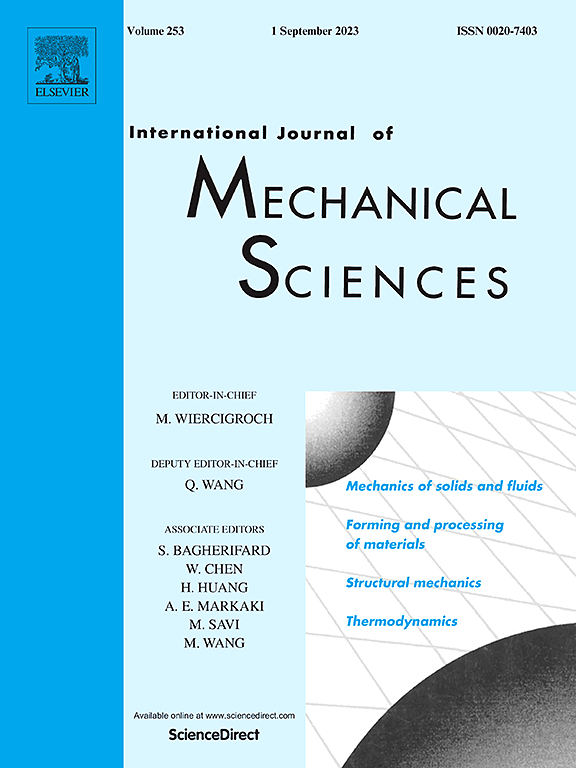梁与晶格结构的粘弹性周动力学模型
IF 7.1
1区 工程技术
Q1 ENGINEERING, MECHANICAL
International Journal of Mechanical Sciences
Pub Date : 2025-06-25
DOI:10.1016/j.ijmecsci.2025.110545
引用次数: 0
摘要
本文讨论了周动力梁粘弹性理论的发展,以模拟梁和晶格结构的蠕变变形。本文的思想是在三维粘弹性本构方程中采用Simo关于变形场的假设,并对其横截面积进行积分,从而得到粘弹性本构方程的力和弯矩合力的简化形式。建立了两个内变量演化方程,并与梁的粘弹性本构方程耦合。这提供了一个总体框架,其中梁中的每个材料点都有6 + 6p个自由度,即三个位移分量,三个增量旋转分量,以及两个矢量内部变量的六个分量,其中p为内部变量的数量。给出了时间推进方案,并给出了力力矩结果和内部变量的更新公式。详细讨论了牛顿-拉夫逊法的数值实现策略。对悬臂梁、框架结构、桁架结构和格构结构的蠕变变形以及压扭格的蠕变破坏进行了大量的数值模拟和验证研究,证实了所提方法的有效性。本文章由计算机程序翻译,如有差异,请以英文原文为准。

Peridynamics model of viscoelasticity for beams and lattice structures
This paper concerns the development of peridynamics beam viscoelasticity theory to model creep deformation in beams and lattice structures. The idea here is to employ Simo’s hypothesis on deformation field in the three-dimensional viscoelastic constitutive equations and integrate over the cross-sectional area which leads to the reduced form of viscoelastic constitutive equations in terms of the force and moment resultants. Two evolution equations for internal variables emerge which are coupled with the beam viscoelastic constitutive equations. This provides a general framework where every material point in the beam has 6 + 6p number of degrees of freedom, viz., three displacement components, three incremental rotation components, and six components of two vector internal variables with p being the number of the internal variables. Time marching scheme and the update formulae for force and moment resultants and internal variables are developed. Numerical implementation strategy using the Newton-Raphson method is discussed in detail. Extensive numerical simulations and validation studies are carried out on creep deformation of cantilever beams, frame structures, truss-frames, and lattice structures, and creep failure of compression-torsion lattice which establish the effectiveness of the proposed method.
求助全文
通过发布文献求助,成功后即可免费获取论文全文。
去求助
来源期刊

International Journal of Mechanical Sciences
工程技术-工程:机械
CiteScore
12.80
自引率
17.80%
发文量
769
审稿时长
19 days
期刊介绍:
The International Journal of Mechanical Sciences (IJMS) serves as a global platform for the publication and dissemination of original research that contributes to a deeper scientific understanding of the fundamental disciplines within mechanical, civil, and material engineering.
The primary focus of IJMS is to showcase innovative and ground-breaking work that utilizes analytical and computational modeling techniques, such as Finite Element Method (FEM), Boundary Element Method (BEM), and mesh-free methods, among others. These modeling methods are applied to diverse fields including rigid-body mechanics (e.g., dynamics, vibration, stability), structural mechanics, metal forming, advanced materials (e.g., metals, composites, cellular, smart) behavior and applications, impact mechanics, strain localization, and other nonlinear effects (e.g., large deflections, plasticity, fracture).
Additionally, IJMS covers the realms of fluid mechanics (both external and internal flows), tribology, thermodynamics, and materials processing. These subjects collectively form the core of the journal's content.
In summary, IJMS provides a prestigious platform for researchers to present their original contributions, shedding light on analytical and computational modeling methods in various areas of mechanical engineering, as well as exploring the behavior and application of advanced materials, fluid mechanics, thermodynamics, and materials processing.
 求助内容:
求助内容: 应助结果提醒方式:
应助结果提醒方式:


